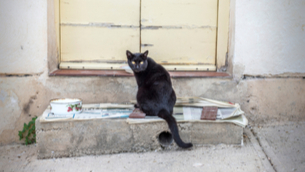| Rylan: | That’s one of my favorite songs of all time, Ceci. Willie Colón, 1984. The man is a genius… Es un genio! |
| Ceci: | He is, Rylan, but our show is not about salsa. |
| Rylan: | Yeah, yeah, I know... The gender of nouns and articles, that’s what we are talking about today. But this song is a great way to start! |
| Ceci: | Here we go… |
| Rylan: | Seriously! Take a look at that line. What do you see? Several nouns but no articles – Gitana, pelo, cara – Let’s ask our listeners if they can determine the gender of those nouns even without the articles! |
| Ceci: | OK, I see what you’re up to – Gitana; Gipsy: do you think it’s masculine or feminine? Pelo; hair: masculine or feminine? |
| Rylan: | Ceci, you have very nice hair. |
| Ceci: | Thank you. |
| Rylan: | In Spanish, do you call your hair “pelo”? Or is it “pela” because you are a woman? |
| Ceci: | Rylan! “Pela” is slang for a beating! |
| Rylan: | Ouch! |
| Ceci: | And that is not how gender works in Spanish. |
| Rylan: | Of course not. But you see my point. That “o”, that humble little letter matters! It’s the cue that gives away the gender of the noun. El pelo is ALWAYS a masculine word, even if it is a lady’s beautiful hair. One letter can make a difference! And this is the topic of today’s show... |
| Ceci: | Hmm… Making a difference, one letter at a time? I think we are covering a little more than that. |
| Rylan: | No, the topic is – drum roll, please – “Everything you wanted to ask about the gender of nouns but were too afraid to ask.” |
| Rylan: | Ok, so what did you have in mind for today? |
| Ceci: | Well… I was planning on first explaining that Spanish is a Romance language, derived from Vulgar Latin, which had gender distinction for ALL nouns and… |
| Ceci: | Really, Rylan? |
| Rylan: | Oh, sorry I don’t know what happened! But speaking of “distinction”, I have an idea. You like poetry, right? |
| Ceci: | Of course. You know very well that my second passion, after teaching Spanish, is... la literatura. |
| Rylan: | So, I was reading “Veinte poemas de amor y una canción desesperada” by Pablo Neruda. |
| Ceci: | One of my favorites. |
| Rylan: | It inspired me! I believe I can sum up the main point of today’s lesson in the form of a poem. Actually, 2 haikus! |
| Ceci: | You think you can teach our entire lesson in 2 haikus? That’s ambitious... |
| Rylan: | Well not all the details; but the essence! -- the 2 principles that will guide our listeners along the way. Do you wanna hear them? |
| Ceci: | How could I refuse? |
| Rylan: | Haiku #1: Some English nouns are masculine or feminine only living things. Haiku #2: All Spanish nouns are masculine or feminine people places things. |
| Ceci: | Bravo, Rylan! I really like that! Now, let’s expand on it a little bit. In English, only nouns that refer to living things have gender; for example uncle/aunt, bull/cow. But in Spanish, every noun, every-single-one, has a gender. |
| Rylan: | Bathroom has a gender. |
| Ceci: | El baño. |
| Rylan: | Computer. |
| Ceci: | La computadora. |
| Rylan: | Intangible things, too, like “revolution.” |
| Ceci: | La revolución. |
| Rylan: | Some nouns are ALWAYS masculine like el pelo, el baño. Others, are ALWAYS feminine, like la cara or la computadora. |
| Ceci: | And some nouns change gender depending on the person or animal they are describing... |
| Rylan: | El gitano o la gitana. |
| Ceci: | Willie Colón canta la gitana. |
| Rylan: | Y yo soy el gitano! |
| Ceci: | You? A gypsy? |
| Rylan: | I never told you how I got that nickname? So, I was heading down to... |
| Ceci: | Wait! Before you launch into a story, we need to talk about the articles. You have already heard us using singular definite articles throughout this conversation: El is the singular definite masculine article, and la is the singular definite feminine article. And that’s it! It’s that simple! Now, Rylan, please tell us how you became... el gitano. |
| Rylan: | When I was travelling in Chile, there was this little train station with a claim to fame. Right next to it was a family-owned food stand that sold… ¡las mejores empanadas del mundo!... The best empanadas in the world, and that’s no exaggeration. I went back so many times that I got to know that wonderful family. They even invited me to stay with them for a short while and, because I moved so frequently and always carried my belongings with me, they started calling me… |
| Ceci: | ¡El gitano! |
| Rylan: | Picture them, Ceci: El hijo, el papá, el abuelo... Un Niño, un hombre, un anciano… |
| Ceci: | Hold on, now you are using the indefinite articles! Quick review: Un for masculine nouns and Una for feminine. |
| Rylan: | That’s right, I’m using them. Don’t worry, everyone will understand! ... El hijo, el papá y el abuelo. Todos juntos en una casa, con un perro y unos pollos. It was a small village, a simple life surrounded by beautiful nature. The whole village felt like... ¡Una familia! |
| Ceci: | But where are all the women? ¿Dónde están las mujeres? |
| Rylan: | La abuela, la mamá, la hija… Una anciana, una mujer y una niña. And I can’t forget el tío y la tía. They all worked together making and selling those empanadas. A family business owned for generations! |
| Ceci: | That kind of love goes into the food! Mmmm.. Now I’m thinking about empanadas. Flaky and buttery... Una empanada hecha con las manos. ¡La perfección! Chilean-style empanadas are delicious, but have you tried the Venezuelan style? They’re made with cornmeal rather than wheat flour, and they’re usually fried not baked. |
| Rylan: | I ate empanadas everywhere I visited in Latin America. They are the perfect food for on the road and good for the budget too! I have tried too many varieties to count, but among the highlights are… Las empanadas de Bolivia, aka las “salteñas” y las empanadas de viento. |
| Ceci: | “Wind” empanadas?! |
| Rylan: | They’re actually filled with cheese, but when they’re fried they puff up and create a pocket of steam that releases its aroma when you bite into them. I could never eat just one! |
| Ceci: | Well, then it’s a good time to mention plural forms. You can quickly recognize a plural noun if you hear or see “s” or “es” at the end of the word. |
| Rylan: | You’re probably already very familiar with that. It’s the difference between: un taco y dos tacos, una empanada y dos empanadas. |
| Ceci: | When a noun is plural, the article that goes along with that noun also becomes plural. They undergo a very similar change. EL becomes LOS for masculine and LA becomes LAS for feminine. |
| Ryan: | La mamá preparó las empanadas. That’s for the definite, now what about those indefinite articles? |
| Ceci: | They follow the same pattern. UNOS is masculine and UNAS is feminine. Now let´s use them altogether... |
| Rylan: | Un gitano y unos amigos van a una casa y preparan unas empanadas. |
| Ceci: | Notice that the plural forms of all of the articles have an -s- at the end, just like the plural forms of nouns: “unos amigos” – “unas empanadas”. |
| Rylan: | I’d like to remind our listeners at this point that articles are nothing to be afraid of. Sure, masculine and feminine forms show some more variation than we are accustomed to in English, but there are still only 8 of them! |
| Ceci: | Correct! The indefinite articles are un, una, unos, unas. And the definite articles are el, la, los, las. We have given you a basic overview of how to match articles with their nouns by gender and number and that will be consistent in most situations. But now we should talk about the exceptions. |
| Rylan: | ¡Ay, no! |
| Ceci: | What? |
| Rylan: | Please, Ceci, I’m going to stop you right there. When people are learning the rules of a language and they hear the word “exceptions,” they roll their eyes or run away screaming. |
| Ceci: | They still need to memorize them though. |
| Rylan: | Actually, Ceci I respectfully disagree. The fact is that there are exceptions but there are FAR more words that fall within the patterns. So, there’s no need to worry now. Even if you incorrectly use an article, you’ll be understood. |
| Ceci: | But how do you propose they learn them? |
| Rylan: | Like I did: naturally! Learn the basic patterns, and dive in! Read short stories, listen to music, watch movies… And at the end of this episode, we’ll share the first chapter of an intriguing story. It’ll be a great place to start. |
| Ceci: | So, you propose that we can learn exceptions by exposure? |
| Rylan: | Yes! |
| Ceci: | Little by little they become part of your vocabulary, effortlessly? |
| Rylan: | Doesn’t that sound nice? |
| Ceci: | Ok… But meet me halfway. Let’s review and practice those basic patterns! |
| Rylan: | Deal. |
| Ceci: | You tell me what you hear: el impacto, el vocabulario, el departamento… |
| Rylan: | El, el, el… o, o, o. They all end in -o- These are all masculine nouns. |
| Ceci: | Now, let’s do the same with feminine nouns. You tell me what’s similar: la diferencia, la pluma, la silla... |
| Rylan: | La, la, la… a, a, a. They all end in -a- And these are feminine, of course… |
| Ceci: | We should also mention these prevalent endings: Most nouns that end in “o” are masculine, but also nouns that end in “or”, like el actor, el conductor. Meanwhile, most nouns ending in “a”, “dad”, “tad”, and “ción/sión” are feminine. La comunidad, la libertad, la comunicación, la expresión. |
| Rylan: | Y hablando de comunicación... |
| Ceci: | Oh boy… |
| Rylan: | It’s relevant, I promise! Un gitano y unos amigos van a una casa y preparan unas empanadas. -- This is a true story -- Yo soy el gitano. Estoy devorando unas empanadas cuando llega la mamá a la casa y dice: “¡Hola, Gordo!” - I’m sitting there stuffing my face and I turn red as a tomato. - “¿Gordo? I reply all incensed and run away. Now, I’ll admit that las empanadas put a few pounds extra pounds on me, but calling me a fatty was so rude! |
| Ceci: | Ay, Rylan. All over Latin America, “gordo” is used as a term of endearment. |
| Rylan: | Well, of course I know that NOW. |
| Ceci: | So what did you do? Did you wander off into the distance… como un gitano misterioso? |
| Rylan: | No. After I figured out what she really meant, I showed her my gratitude for her hospitality. I marched right back into her kitchen and ate a ton of her empanadas! |
| Ceci: | One more mention of empanadas and my stomach is going to growl. |
| Rylan: | You and me both! Luckily I know a place we can go after this episode... ¡Vamos a comer unas empanadas auténticas! |
| Ceci: | ¡Fantástico! But not before we get back to Mr. Willie Colón... “Gitana, pelo, cara”... In that line of the song, he uses no articles. Dear listeners, can you identify the gender of these words and attach the appropriate article? |
| Rylan: | La gitana, el pelo, la cara. |
| Ceci: | And how do you know that you’re not dealing with a dreaded EXCEPTION? |
| Rylan: | Simply because, out of the goodness of your heart you would have corrected me by now! |
| Ceci: | Fair enough. And now, out of the goodness of your heart, lead the way to those empanadas. |

























